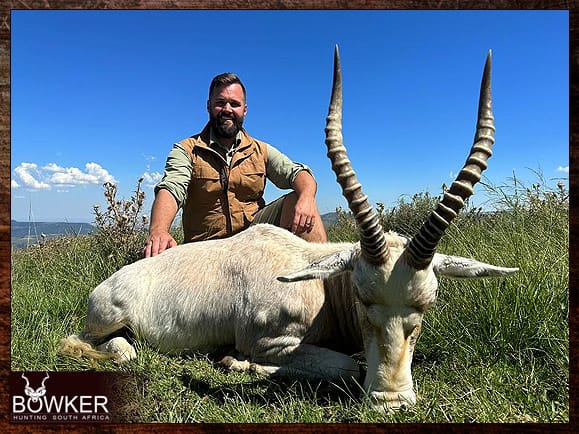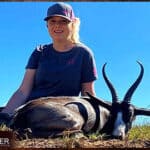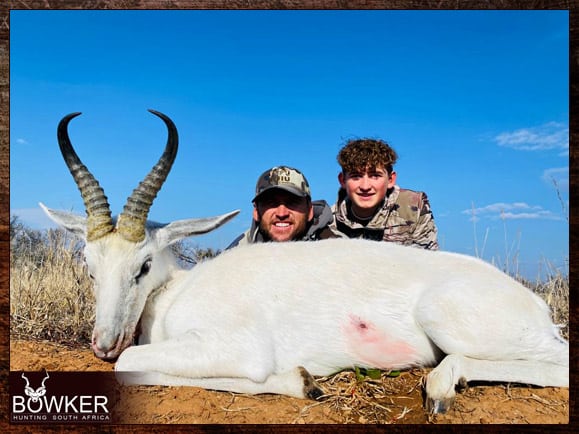
Summary
Black Impala hunting is conducted in woodland and savanna areas—a trophy most hunters take on their first African hunt. When a hunter sets foot in Africa, the adventure begins with the pursuit of unique game like the black impala. Hunting impala is on the agenda for just about every hunter who sets foot in South Africa.
The smooth skin and two-tone red coloration make for a unique trophy hunt. Black impala frequents open woodlands and savanna, often found near watering holes and feeding areas, as they need to drink daily. The impala is a sociable herd animal that frequents open woodlands and the bushveld.

There are no seasonal restrictions on an impala hunt in Eastern Cape, South Africa. However, the autumn rut is an optimal time to hunt for the best rams, as trophy impala with excellent trophy quality are most active within breeding herds.
The best time to hunt Black Impala is during the rut in April and May, when males are especially active, fighting for dominance and making them easier to identify for trophy selection. The best time to hunt Black Impala is during the rut in May.
Bowker Hunting offers Black Impala Hunting safari hunts year-round. These hunts take place on excellent concessions, known for their well-managed and prime hunting grounds.
Black impala hunts are conducted in savanna and woodland areas, where impalas are most active during the early morning and cooler times of the day. Ambushes near known feeding areas and watering holes can increase the chances of a successful hunt. Impala are most active during the cooler times of the day, early morning and later in the afternoon.

Hunting black impala is more favorable when looking for bachelor herds of rams rather than breeding herds. Hunters often seek the best rams and trophies, making trophy quality a key consideration. The herd’s propensity to herd tightly requires hunters to exercise great caution, as this behavior can make hunting challenging and demands careful shot placement. Impala tend to herd tightly together when alarmed, making it easy to shoot more than one with a single shot.
Black Impala are social animals and must be approached with caution during the hunt. Only an experienced hunter should attempt certain advanced hunting techniques.
Impala has terrific eyesight.
Safaris are conducted from Hopewell Lodge in the Eastern Cape, where hunters can also encounter kudu, zebra, red hartebeest, black wildebeest, mountain reedbuck, and dik dik among other notable game species.
Table of Contents
Introduction to Impala Hunting
Impala hunting stands out as one of the most thrilling and accessible adventures for hunters visiting Africa, especially in South Africa. The impala, a medium-sized antelope, is renowned for its sociable herd animal nature and the elegant, lyre-shaped horns that make it a sought-after trophy. The lyre-shaped horns are only carried by the rams. For the newly initiated African hunter, pursuing impala offers an ideal introduction to the continent’s diverse wildlife and hunting traditions.
Whether you prefer rifle hunting or bow hunting, tracking these fascinating animals through the bush is both challenging and rewarding. Impalas are known for their agility and alertness, making every hunt a true test of skill and patience. With expert guidance and the right equipment, hunters of all experience levels can enjoy the excitement of impala hunting and the satisfaction of bringing home a unique African trophy.
Whether you prefer rifle hunting or bow hunting, tracking these fascinating animals through the bush is both challenging and rewarding. Impalas are known for their agility and alertness, making every hunt a true test of skill and patience. With expert guidance and the right equipment, hunters of all experience levels can enjoy the excitement of impala hunting and the satisfaction of bringing home a unique African trophy.

Black Impala Habitat and Behavior
The black impala, a rare and striking color morph of the common impala, is found in select regions of South Africa and southern Africa. These unique animals thrive in open woodlands and areas of dense brush, where their dark coats provide a dramatic contrast to the landscape. Black impalas are typically seen as part of larger herds, often led by a dominant ram, and their herd’s propensity to stick together makes them both a challenging and rewarding quarry.

Impala Hunting
The Black Impala is a color variant of the southern Impala. A must for collectors interested in collecting both Impala color variations. It’s a great trophy to hunt while on safari.
The black African Impala is not a subspecies but a color phase of the southern Impala. Black Impala was developed by selective breeding; the skin color is all black.
A white-flanked Impala is another color variant available to plains hunt in South Africa while on safari.

Impala Hunts
Black Impala has all the same traits as the southern Impala.
Hunting a black Impala trophy is no different from a Southern Impala hunt and usually involves spot and stalk.
The black-faced impala, as opposed to the black impala, is unique to Nambia and unavailable in the Eastern Cape.
The common impala is a different species from the black-faced impala.

Black Impala Hunting Safari
We offer competitive rifle-hunting packages. Impala hunts take place on our ranch in South Africa. Impalas are plentiful and free-ranging, and hunting prices are cheap. They are hunted and shot by walk and stalk methods.
When hunting impala, shot placement is crucial for ethical hunting and optimal meat recovery. For an ethical and effective kill, aim for the lungs, as this is a key target area that ensures a quick and humane harvest. A high lung shot is often the best bet for a clean kill, as it maximizes success and minimizes meat spoilage. Aim a bit higher or shoot directly up the fore leg to increase your chances of hitting vital organs. A single shot, if placed correctly, is usually sufficient to bring down an impala. The best shot placement for hunting impala is a high heart/lung shot.
The recommended calibers for hunting impala are between 6mm to 30 caliber. Choosing the right caliber is a far better choice for effective hunting, especially when tracking wounded animals. Always shoot with care to avoid hitting more than one animal, particularly when the herd includes female impala. Sustainable hunting practices, such as focusing on less meat consumption and making full use of the meat from your hunt, are encouraged.
Consider shooting a black impala as an add-on to one of our hunting packages on your Africa hunt.
Visit our contact pages to get detailed booking and hunting information.
Shot Placement and Ethics
When hunting impala in South Africa, particularly the rare and sought-after black impala, shot placement and ethics are of paramount importance. The goal is to achieve a quick, humane kill, which not only respects the animal but also ensures the best possible outcome for the hunter. For medium-sized antelopes like impalas, a high heart/lung shot is considered the most effective, as it targets the vital organs, leading to a swift and merciful death. This shot placement is crucial, especially when hunting in dense brush or during the autumn rut when impalas are more active and alert.
To achieve the perfect shot, hunters should aim directly up the foreleg, about one-third or a bit higher, and slightly to the rear for lung shots. This technique requires patience, a keen sense of the animal’s anatomy, and calculated stalks to get within range without startling the impala. The use of appropriate calibers, ranging from 6mm to 30 caliber, is also vital, as it ensures sufficient power to penetrate deep into the animal without causing unnecessary suffering.
Ethical hunting practices are essential in preserving the integrity of the hunt and ensuring the sustainability of impala populations in South Africa. Hunters should always strive to make a single, well-placed shot, avoiding the risk of wounding the animal or, worse, hitting other impalas in the herd. The eastern cape of South Africa, known for its abundant plains game, including impalas, wildebeest, and other species, offers hunters a unique and challenging experience, emphasizing the need for responsible and ethical hunting practices.
For African hunters, both seasoned and novice, understanding the importance of shot placement and adhering to ethical standards is not only a matter of personal pride but also a contribution to the conservation of these magnificent creatures. By choosing to hunt with reputable safaris and outfitters that prioritize ethical hunting, hunters can ensure that their experience is not only memorable but also beneficial to the ecosystem and local communities.
In the context of black impala hunting, which is considered a rare and unique trophy experience in Africa, the emphasis on ethical hunting and precise shot placement is even more pronounced. Given the black impala’s status as a melanistic variant of the common impala, found primarily in certain regions of South Africa and southern Africa, hunters must approach the hunt with a deep respect for the animal and its habitat. This includes recognizing the impala’s keen sense of hearing, smell, and excellent eyesight, which demands cautious and calculated stalks.
Ultimately, the hunting experience, whether for black impala or other species, should be guided by a commitment to ethical practices, a thorough understanding of the animal’s behavior and anatomy, and a passion for the conservation of Africa’s incredible wildlife heritage. By embracing these principles, hunters can ensure that their pursuit of trophies like the black impala contributes positively to the preservation of these animals and their habitats, for generations to come.
Black Impala
The cost of a black impala hunt can vary based on several factors, including the location, hunting method, and the time of year. In South Africa’s Eastern Cape, trophy fees for black impala typically range from $2,500 to $3,000. When planning your impala hunt, it’s important to factor in daily rates, which cover accommodation, guiding, and other services, bringing the total for a 5-day hunt to around $3,500 or more.
Hunters interested in rifle hunting or bow hunting should also consider additional expenses, such as permits, ammunition, and the potential costs associated with tracking wounded impala. If you’re looking to expand your safari, you may encounter extra trophy fees for other sought-after species like blue wildebeest or cape buffalo. By understanding the full scope of costs and planning accordingly, hunters can ensure a smooth, enjoyable, and successful black impala hunting experience in Africa.
Bowker Hunting deals are always fully inclusive of day rates, food and accommodation.
Black Impala Hunting Trophy Fees in South Africa
How much does it cost to hunt a Black Impala?
The cost of a black impala hunt can vary based on several factors, including the location, hunting method, and the time of year. In South Africa’s Eastern Cape, trophy fees for black impala typically range from $2,500 to $3,000.























































































































































